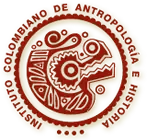Pontificia Universidad Javeriana | |
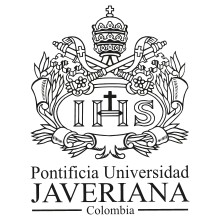 | |
| Latin: Pontificia Universitas Xaveriana | |
| Motto | Sapientia Aedificavit sibi Domum (Latin) |
|---|---|
Motto in English | Wisdom has built a Home for itself |
| Type | Private Roman Catholic Research Non-profit Coeducational Higher education institution |
| Established | 1623 |
| Accreditation | CHQ |
Religious affiliation | Roman Catholic (Jesuit) |
Academic affiliations | CCE Association of Colombian Universities Universia |
| President | Fr. Jorge Humberto Peláez Piedrahita, SJ |
Academic staff | 3,040 |
| Undergraduates | 19,682 |
| Postgraduates | 3,470 |
| Location | Carrera 7 No. 40 – 62 Bogotá D.C. , Colombia 4°37′44″N 74°03′53″W / 4.62889°N 74.06472°W |
| Campus | Urban, 445 acres (180 ha) |
| Language | Mostly Spanish |
| Radio Station | Javeriana Estéreo 91.9 FM |
| Colors | Blue White Yellow |
| Nickname | La Javeriana / La Ponti |
| Mascot | Kiwi the Black Cat |
| Website | www |
The Pontificia Universidad Javeriana (English: Javeriana University) is a private university in Colombia founded in 1623. It is one of the oldest and most traditional Colombian universities, directed by the Society of Jesus, with its main facilities in Bogotá and a second campus in Cali. "La Javeriana", as it is known by its students, has traditionally educated the Colombian elite. It is one of the 33 universities entrusted to the Society of Jesus in Latin America and one of 167 around the world.[1]
The Javeriana University in Bogotá has 18 schools comprising 61 departments and 242 academic programs catering to areas of knowledge, giving the university its multidisciplinary nature.[2] It has 45 buildings in 445 acres (1.80 km2). The Javeriana University in Cali offers 18 schools in four faculties. It is located in Pance, Cali. Its Law School recently received a high-quality accreditation by Resolution 6808 6 August 2010, of the Ministry of National Education. The campus in Cali has sectional divisions of the Bolsa de Valores de Colombia (BVC), Temple University's Fox School of Business, and others.1623.[1]
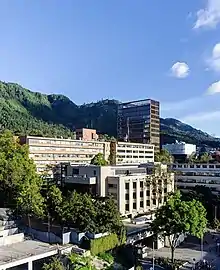
The university is one of the twelve universities in Colombia having a high-quality institutional accreditation, granted to it for eight years by Resolution 1320, 12 June 2003, of the Ministry of National Education.[3]
The university has 21 undergraduate programs with high-quality accreditation, and eight programs in advanced stages of the accreditation process. In graduate programs, quality is acknowledged through the Qualified Registries. The university has over 87 graduate programs. According to the QS World University Rankings in 2023, the university was ranked #382 globally, #18 in Latin America, and #3 in Colombia.[4]
History
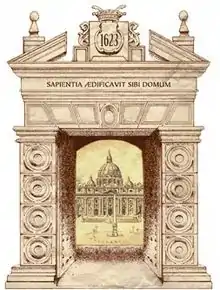
The College of the Society of Jesus was established in Santafé de Bogotá in 1604 as part of the San Bartolome School and Cloister. In 1623, the Audience and the Archbishop recognized the academic degrees conferred by the college. The students at that time received their degree, including Pedro Claver. That is the origin of what was known as the University and Academy of Saint Francis Xavier. In 1767, the Jesuits were expelled from the Spanish colonies, which closed the first stage of Universidad Javeriana's history.[5]
Then 163 years after the university closed, an act of restoration was signed. In 1937 the School of Economics and Legal Sciences was founded, with the others following. In 1970, after multiple petitions from the community of Cali, the university started a program in that city. The Universidad Javeriana in Cali took the name of "Cali Branch", offering degrees in business, engineering, and psychology.
Campus
Main Campus in Bogotá
The university's main campus has a total area of 445 acres (180ha) and approximately 202,988 spared meters of construction. Inside, there are a total of 45 buildings, 18 cafeterias, 1 university bookstore, a hospital, 1 parking block building with 1200 parking spaces, and 1 travel agency. The main campus is located inside the locality of Chapinero in eastern Bogotá since 1940. This campus borders important city landmarks such as the Parque Nacional Enrique Olaya Herrera to the south, the emblematic Carrera Séptima (seventh street) on the west end, the Eastern Hills (Bogotá) and the traditional Chapinero Block to the north. Today this university maintains its open campus environment that allows pedestrians to walk on the interior.
A brief history of some of the university's most emblematic buildings: Most Buildings are named after previous presidents or deceased Jesuit Faculty members who were important members of the academic community.
- 1951: The university begins its modern development with the construction of the Edificio Emilio Arango, S.J., today this building is home to the university's central government and administration.
- 1955: Hospital Universitario San Ignacio is built, home to the school of Medicine.
- 1954: The inauguration of the Edificio Félix Restrepo, S.J. alongside the programs of Bacteriology, Art and Decorations, Law, Nursing, Commerce, and Philosophy.
- 1958: The Architecture workshops are opened.
- 1959: Female in-campus Housing facilities, which today is known as Edificio Carlos Ortiz, S.J.
- 1976: The Jesús María Fernandez, S.J. Building is open to the public. Today it houses the Main library named after Alfonso Borrero Cabal S.J.
- 1980 -1990: The new phase of development begins, with buildings such as José Gabriel Maldonado, S.J. Building, home to the school of Engineering and all its departments.
- 1991: The Gabriel Giraldo, S.J., custom made for The School of Law and The School of Political Science and International Relationships. In 1993, the Lecture room Building Fernando Barón, S.J. is built, and in 1996 the parking lot building with room for 1,200 vehicles.
- 2000: The university expands its physical development to the southeast with the Pedro Arrupe, S.J. Building where the School of Theology is located. Alongside this building there is also the Javeriana Centre for Sport Education (Gym, Sports and Training Facilities) and the Manuel Briceño, S.J. Building for The School of Psychology, The School of Social Sciences, and The School of Philosophy.
- 2008: The university begins construction for "The Master Plan for The Development of The University's Infrastructure" alongside the very strict policy for ecological and environmental preservation. This plan includes the construction of the new Comparative Biology Building (2009), The Faculty of Arts Building (2014), the Jorge Hoyos, S.J. Building (now nicknamed "The Arc" for its peculiar architectural design) which opened in 2016, The ATICO Center (2009), one of the most technologically advanced buildings in Latin America for the Arts and Communication Studies (Atico is an acronym in Spanish for "High Technology, information, and computing"), The School of Engineering Laboratory Building (the tallest building on campus with a total of 15 floors) that opened its doors in 2020, the new Science Labs Building, and the Continuing Studies off-campus Building in the northern part of the city which is still under construction. The master plan also includes the construction of a new and more modern Hospital, an auditorium capable of holding ceremonies with up to 1,800 people at once, the new School of Architecture and Design Building, and an expansion to the gym facilities to include an on-campus pool.
Cali Branch
The Pontificia Universidad Javeriana of Cali is located to the south of the city, in Pance, next to Farallones de Cali, which are part of the Andes Mountain Range. It has a more rural ambiance where vegetation is abundant and is not rare to see local fauna. This promotes a safe and calm environment for the students. This campus has eight Buildings: Las Palmas, Guayacanes Building, Lecture Hall of The Lake, Administrative Offices, Samán Building, Almendros Building, Continuing Studies Building, Acacias Building, The Pink Cedar Building, and the Library. Currently, there are 2 more buildings under construction. It also has 5 cafeterias, a bookstore, parking lots, a center for the Colombian Stock Market, and a Subsidiary of the Fox School of Business from Temple University.
Academics
The university offers 46 undergraduate programs and 179 graduate programs including, 94 professional specializations, 45 medical and surgical specializations, 8 dentistry specializations, 72 masters, and 13 PhDs.[6]
Schools and departments
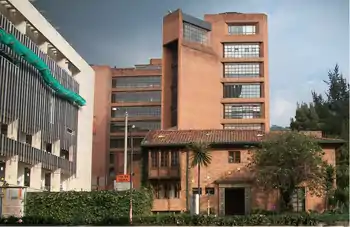
- School of Theology
- School of Philosophy
- School of Medicine
- School of Dentistry[7]
- School of Nursing
- School of Psychology
- School of Law
- School of Political Science and International Relations
- School of Arts: visual arts, performing arts, music[8]
- School of Social Sciences: anthropology, history, literature, sociology, cultural studies
- School of Sciences: biology, mathematics and physics, microbiology, nutrition & biochemistry, chemistry
- School of Engineering: civil engineering, industrial engineering, electronic engineering, systems engineering, telecommunications engineering, mechanical engineering, mechatronics, bioengineering, data science
- School of Economics and Management Sciences: management, accounting, economy, finances.
- School of Education: child pedagogy, basic education emphasizing Spanish and human sciences[9]
- School of Communication and Language: communication studies, information science, languages and linguistics
- School of Design and Architecture: architecture, industrial design, design of visual communication
- School of Environmental and Rural Studies: ecology, rural and regional development
Research
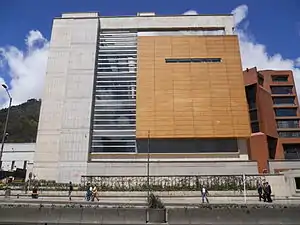
The university has 61 departments and 14 institutes.[10] Departments are academic units aimed at developing an area of knowledge through research, teaching, and the implementation of services such as continuing education, counseling, and advisory activities. Institutes are academic units responsible for research and consulting in areas requiring a special interdisciplinary approach.
To provide technological support to research, education, service and administrative processes, the university has next-generation network services. Mention can be made of the technological components available in the following units: The SIU (University Information System, acronym in Spanish) with its "People Soft" platform for Academic Management; the New Technologies-Aided Education Center (CEANTIC) that offers virtual courses support through its Blackboard platform; the Centro Audiovisual Javeriano, with front edge technology in this field in Latin America, internationally accredited like Autodesk Training Center-ATC; the Computer-Aided Architecture and Design Project, CAAD; the Technological Industrial Automation Center; the Geo-referenced Information Center, GIC; the Javeriana Center of Oncology; the San Ignacio University Hospital; and the Magnetic Resonance Imaging Center. It also has 130 laboratories and workshops.[11]
La Javeriana is among the leading universities researching the Muisca people and culture.[12][13][14][15][16]
Libraries

The Xavierian University has four libraries: The General Library, the Mario Valenzuela, S.J., Library, which specializes in philosophy and theology and is rated as the best in these disciplines in Latin America, the Alfonso Llano Escobar, S.J. Bio-ethics Library, and the CIRE (Centre for Ignatius Reflection and Exercises) Library. It has seven document and resource centers in the following fields of knowledge: bio-ethics, political science, architecture, psychology, law, insurance, social communication, and clinical epidemiology.
The library stock numbers 418,008 titles among books, magazines, journals, thesis and dissertation papers, music scores, maps, VHS and DVD film recordings, slides, sound videos, and sound recordings. The system has about 90 subscriptions to databases and has access to complete text contents for online consultation of journals, books, thesis and dissertation papers, and digital format slides.
It offers services such as the drafting of bibliographic references on specialized subjects and bibliographic exchange allowing data gathering that includes journal articles and other documents from libraries in Colombia and around the world. It serves the Javeriana community throughout a 24-hour schedule, Monday through Friday.[17]
University Presidents and Executive Officers
Colonial Era University Presidents
- Baltasar Mas Burgués, S.J. – 1623
- Sebastián Murillo, S.J. – 1628
- Francisco de Fuentes, S.J. – 1636
- Francisco Sarmiento, S.J. – 1639
- Baltasar Mas Burgués, S.J. – 1641
- Juan Manuel, S.J. – 1642 – 1645
- Pedro Fernández, S.J. – 1646
- Juan Gregorio, S.J. – 1651
- Francisco Varaiz, S.J. – 1653
- Juan Gregorio, S.J. – 1657
- Gaspar Cujía, S.J. – 1659
- Bartolomé Pérez, S.J.
- Juan de Santiago, S.J. – 1673
- Juan Martínez R., S.J. -1677 – 1681
- Francisco Alvarez, S.J. – 1682
- Pedro de Mercado, S.J. – 1686
- Pedro Calderón, S.J. – 1706
- Diego de Tapia, S.J. – 1733 – 1734
- Mateo Mimbela, S.J. – 1735
- Francisco Cataño, S.J. – 1737
- Jaime López, S.J. – 1738 -1741
- Tomás Casabona, S.J. – 1743 – 1749
- Ignacio Ferrer, S.J. – 1756
- Manuel Román, S.J. – 1761
- Manuel Zapata, S.J. – 1764 – 1765
- Nicolás Candela, S.J. – 1767
Modern University Presidents
- José Salvador Restrepo, S.J. 1930 – 1932
- Jesús María Fernández, S.J. 1932 – 1935
- Alberto Moreno, S.J. (E) 1935
- Carlos Ortiz, S.J. 1935 – 1941
- Francisco Javier Mejía, S.J.(E) 1941
- Félix Restrepo, S.J. 1941 – 1950
- Emilio Arango, S.J. 1950 -1955
- Carlos Ortiz, S.J. (E) 1955 – 1956; (rector) 1956 – 1960
- Jesús Emilio Ramírez, S.J. 1960 – 1966
- Fernando Barón, S.J. 1966 – 1970
- Alfonso Borrero, S.J. 1970 – 1977
- Roberto Caro, S.J. 1977 – 1983
- Jorge Hoyos Vásquez, S.J. 1983 – 1989
- Gerardo Arango Puerta, S.J. 1989 – 1998
- Gerardo Remolina Vargas, S.J. 1999 – 2007
- Joaquín Emilio Sánchez, S.J. 2007 – 2014
- Jorge Humberto Pelaez Piedrahita, S.J. 2014 – Present
Current Executive Officers
- Great Chancellor: Adolfo Nicolás, S.J.
- Vice Great Chancellor: Carlos Eduardo Correa Jaramillo, S.J.
- President: Jorge Humberto Peláez Piedrahita, S.J.
- Provost: Luis David Prieto Martínez
- Vice President for University Welfare: Luis Alfonso Castellanos Ramírez, S.J.
- Vice President for Administration: Catalina Martinez de Rozo
- Vice President for Interinstitutional Relations: Luis Fernando Álvarez Londoño, S.J.
- Vice President for Research: Luis Miguel Renjifo
- General Secretary: Jairo Humberto Cifuentes Madrid
Cali Branch

On 6 October 1970, responding to requests from the local community and the efforts of a group of practicing accountants who aspired to obtain the university degree, a Program of Public Accounting began in Cali. This was the origin of the Cali branch of the Javeriana University. On 20 November 1978 the board proposed the name Cali Branch, with headquarters in the capital under the same organization and higher authorities. The board of regents, at the request of the board, adopted the name Cali Branch.
The campus of the Pontificia Universidad Javeriana Cali is located in the south of the city, in Pance, at the foot of the Farallones de Cali, part of the Cordillera Occidental (Colombia), in a totally rural environment where vegetation and fauna abound. The campus consists of nine buildings (Las Palmas, Guayacanes, classrooms block, administration, Saman, Almendros, continuing education, Las Acacias and Cedro Rosado). The campus features multiple cafés and restaurants, the Javeriana Shop, a large parking lot surrounding the entire campus, a branch of Corpbanca, a center of the Colombia Stock Exchange, and an MBA extension of Temple University Fox School of Business and Management. The campus also includes Alfonso Borrero Cabal auditorium; Central Library, one of the most complete in the Colombian Southwest; Loyola Sports Center; the office of entrepreneurship "Campus Nova", which fosters entrepreneurial talent within the university; and the Javeriano Writing Center, highly regarded for helping students develop writing skills.
The university has 35 research groups attached to the government Administrative Department of Science, Technology and Innovation; and a station, Javeriana Stereo FM 107.5 with a wide audience in the Colombian Southwest. It offers students opportunities in more than 87 countries and boasts 120 academic cooperation agreements with universities abroad.
Currently, the Pontificia Universidad Javeriana Cali offers 19 undergraduate programs of which eight have received quality accreditation by the Ministry of Education (Civil Engineering, Electronics Engineering, Industrial Engineering, Systems Engineering and Computer Science, Business Administration, Accounting law and Psychology). It is well known for its Law and International Business degrees. The law degree from the Pontificia Universidad Javeriana Cali is prestigious in Cali and the Colombian Suroccidente, profiting from one of the most complete moot courts for student practice. The Cali branch of the Faculty of Health Sciences inaugurated the Moot Hospital which has high-tech teams and a superior infrastructure for student interns.
In March 2012, the Pontificia Universidad Javeriana Cali received the Institutional Accreditation of High Quality from the Ministry of Education for eight years, placing it among the more competitive private universities in the country.
Alumni

Javeriana's alumni include a vast range of prominent individuals in the history of the country and the region, with the following (non-exhaustive) list representative, including Presidents of Colombia, Vice Presidents of Colombia, National and International Ministers, Grammy Award-winning artists, Academy Award-nominated artists, Tony Award-nominated artists, Miss Universe, Olympic medallists and people included in Forbes and BBC lists.
- Camilo Prieto Valderrama, climate science professor and environmentalist.
- Ernesto Samper, President of Colombia (1994–1998)
- Daniel Samper Pizano, lawyer, journalist, and writer
- Daniel Samper Ospina, comedian, writer, journalist, and columnist
- Misael Pastrana, president of Colombia (1970–1974)
- Marta Lucía Ramírez, vice president of Colombia (2018–2022); 2021 Forbes list of the Colombian 50 most powerful woman
- María Juliana Ruiz, first lady of Colombia (2018–2022)
- Rodolfo Llinás, neuroscientist, University Professor at the New York University; Director of the Neurolab Research on the NASA and Ralph W. Gerard Prize laureate
- Luis Carlos Galán Sarmiento, politician
- Gustavo Bell, vice president of Colombia (1998–2002)
- Peter Claver, priest and missionary
- Ignacio Martín-Baró, scholar, psychologist, philosopher and jesuit priest
- Marcela Ocampo Duque, lawyer, Executive Manager Banco de la Republica
- Gustavo Petro, President of Colombia (2022-), left-wing politician; mayor of Bogotá (2014–2015) and member of the Colombian senate (2006–2010, 2018–2022)
- Vicky Colbert, Politician and Sociologist; 2017 BBC 100 Women
- Catalina Sandino Moreno, Academy Award-nominated actress
- Catalina Robayo, Miss Colombia 2010, placed Top 16 at Miss Universe 2011.
- Alejandro R. Jadad Bechara, physician, innovator, networker and humanist
- Henry Krieger, Broadway producer; Grammy Award-winning and Tony Award-nominated producer
- Ángela Robledo, psychologist, member of the Chamber of Representatives of Colombia
- Fernando Araújo Perdomo, former Minister of Foreign Affairs of Colombia (2007–2008)
- Noemí Sanín, former minister of Foreign Affairs of Colombia, former ambassador to the United Kingdom and Spain
- Óscar Iván Zuluaga Escobar, former Minister of Finance and Public Credit (2007–2010)
- Juan Carlos Pinzón, former minister of defense (2011–2015) and Ambassador of Colombia to the United States (2015–2017, 2021–)
- Gina Parody, former Minister of Education (2014–2016)
- Aurelio Iragorri Valencia, former minister of interior of Colombia (2013–2018)
- Claudia Blum, psychologist; former minister of foreign affairs (2019–2021)
- Natalia Abello Vives, former minister of transport of Colombia (2014–2018)
- Diego Molano Vega, former Minister of Information Technologies and Communications (2010–2014)
- Carlos Holguín Sardi, former minister of the Interior and Justice in Colombia (2006–2008)
- Juan Camilo Restrepo Salazar, former minister of agriculture and rural development of Colombia (2010–2013)
- Fernando Londoño, former minister of the interior and justice of Colombia (2002–2004)
- Juan Carlos Esguerra Portocarrero, former minister of justice and law of Colombia (2011–2012)
- Ricardo Velez Rodriguez, Brazilian Minister of Education
- Álvaro Gómez Hurtado, former Colombia Ambassador to the United States (1983–1985) and former Colombia ambassador to France (1991–1993)
- Jorge Franco, writer; Alfaguara Prize 2014
- Jorge Alfredo Vargas, news presenter
- Jorge Enrique Abello, actor; participated in Yo soy Betty, la fea, Betty en NY, iCarly and others
- Santiago Gamboa, writer
- Fonseca, singer; Grammy Award-nominated and Latin Grammy Award-winner artist
- Laura Tobón, model, beauty & fashion blogger
- Simón Brand, Hollywood director
- Vanessa de la Torre, journalist
- Riyad al-Maliki, minister of Foreign Affairs of Palestinian Authority
- Ignacio Martín-Baró, Spanish philosopher and psychologist
- Claudia Palacios, former anchor for CNN en Español
- Carlos Pizarro Leongómez, politician, commander of M-19 (dropped out)
- Mario Mendoza Zambrano, writer
- Fernando Vallejo, writer
- Paulina Dávila, actress
- Jackeline Rentería, Olympic medallist (2008, 2012)
- Kristina Lilley, American born-Colombian actress (She studied Biology before she became an actress).
- Paulina Vega, Miss Colombia 2013 and Miss Universe 2014; 2021 Forbes list of the Colombian 50 most powerful woman
- Giancarlo Mazzanti, architect
- Brigitte Baptiste, Environmental scientist and researcher, President of the EAN University and 2021 Forbes list of the Colombian 50 most powerful woman
- Ricardo La Rotta Caballero, architect
- Camilo Prieto Valderrama, surgeon and environmentalist
- Diana Wiswell, actress.[18]
- General Freddy Padilla De León, former commander of the Colombian Armed Forces, former Minister of Defense, ambassador
- Daniel Vivas Barandica, journalist and communicator.[19]
Lecturers
- Miguel Gómez (photographer) (born 1974), Colombian / American photographer, worked in the Fine Arts department for several years.
- Carlos Serrano (born 1963), Colombian classical musician, worked for the music school.
See also
References
- 1 2 "Home | Pontificia Universidad Javeriana". javeriana.edu.co (in European Spanish). Retrieved 17 October 2017.
- ↑ "TOP CAREER STUDY ABROAD | Pontifical Xavierian University". study.topcareer.jp. Archived from the original on 17 October 2017. Retrieved 17 October 2017.
- ↑ "Pontifical Javeriana University". Times Higher Education (THE). Retrieved 17 October 2017.
- ↑ "Pontificia Universidad Javeriana". QS World University Rankings. Retrieved 18 October 2022.
- ↑ "CATHOLIC ENCYCLOPEDIA: The Suppression of the Jesuits (1770–1773)". newadvent.org. Retrieved 17 October 2017.
- ↑ "Oferta de programas". Javeriana.
- ↑ "Dentistry. Accessed 30 September 2016". Archived from the original on 7 September 2008.
- ↑ "Carrera: Artes Visuales | Pontificia Universidad Javeriana". puj-portal.javeriana.edu.co (in European Spanish). Archived from the original on 3 December 2013. Retrieved 17 October 2017.
- ↑ Marroquin, Omayra Parra de; Corredor, Lina Clarizia (1 January 2002). "Open University Center of the Pontifical Javeriana University, Colombia". The International Review of Research in Open and Distance Learning. 2 (2). ISSN 1492-3831.
- ↑ "Colombia: Pontificia Universidad Javeriana". American University. Retrieved 17 October 2017.
- ↑ "Pontificia Universidad Javeriana". ResearchGate. Retrieved 17 October 2017.
- ↑ Langebaek Rueda, Carl Henrik (2005a). "La élite no siempre piensa lo mismo" [The elite does not always think the same]. Muiscas: representaciones, cartografías y etnopolíticas de la memoria (in Spanish). Universidad La Javeriana. pp. 180–199. ISBN 958-683-643-6.
- ↑ Correa, François (2005). "El imperio muisca: invención de la historia y colonialidad del poder" [The Muisca empire: invention of history and power colonialisation]. Muiscas: representaciones, cartografías y etnopolíticas de la memoria (in Spanish). Universidad La Javeriana. pp. 201–226. ISBN 958-683-643-6.
- ↑ Trimborn, Hermann (2005). "La organización del poder público en las culturas soberanas de los chibchas" [The public power organisation in the common cultures of the Chibchas]. Muiscas: representaciones, cartografías y etnopolíticas de la memoria (in Spanish). Universidad La Javeriana. pp. 298–314. ISBN 958-683-643-6.
- ↑ Gómez Londoño, Ana María (2005). Muiscas: representaciones, cartografías y etnopolíticas de la memoria [Muisca: representations, cartographies and ethnopolicies of memory] (in Spanish). Pontificia Universidad Javeriana. ISBN 9789586836432. Retrieved 8 July 2016.
- ↑ Guarín Martínez, Óscar (2005). "De bárbaros a civilizados: la invención de los muiscas en el siglo XIX" [From brutals to civilised: the invention of the Muisca in the 19th century]. Muiscas: representaciones, cartografías y etnopolíticas de la memoria (in Spanish). Universidad La Javeriana. pp. 228–246. ISBN 958-683-643-6.
- ↑ "Sistema de Bibliotecas Javeriano – SIBJA | Pontificia Universidad Javeriana | Pontificia Universidad Javeriana". javeriana.edu.co (in European Spanish). Retrieved 17 October 2017.
- ↑ "'La Reina del Flow 2': los que repiten y los nuevos en la serie". 15 April 2021. Retrieved 20 April 2021.
- ↑ "Daniel Vivas Barandica el periodista que entrevistó a Popeye colaborador de Pablo Escobar | CanaldelaMona" (in Spanish). 5 January 2024. Retrieved 9 January 2024.
